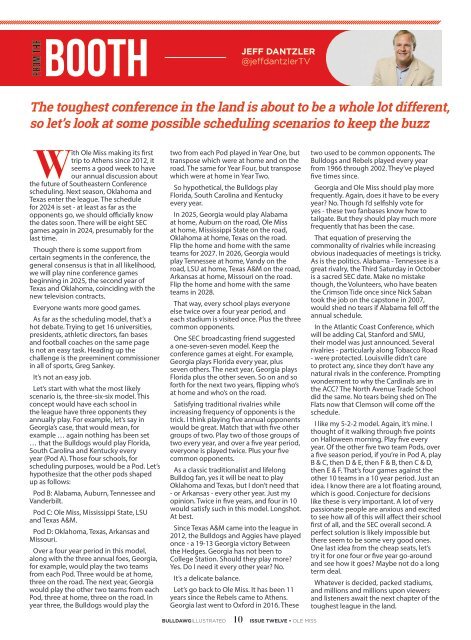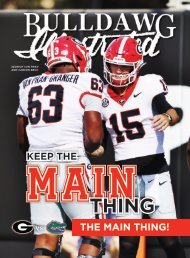College Gameday Comin' To Our City - Go Dawgs And Hotty Toddy - Let's Go
Create successful ePaper yourself
Turn your PDF publications into a flip-book with our unique Google optimized e-Paper software.
FROM THE<br />
booth<br />
JEFF DANTZLER<br />
@jeffdantzlerTV<br />
The toughest conference in the land is about to be a whole lot different,<br />
so let’s look at some possible scheduling scenarios to keep the buzz<br />
With Ole Miss making its first<br />
trip to Athens since 2012, it<br />
seems a good week to have<br />
our annual discussion about<br />
the future of Southeastern Conference<br />
scheduling. Next season, Oklahoma and<br />
Texas enter the league. The schedule<br />
for 2024 is set - at least as far as the<br />
opponents go, we should officially know<br />
the dates soon. There will be eight SEC<br />
games again in 2024, presumably for the<br />
last time.<br />
Though there is some support from<br />
certain segments in the conference, the<br />
general consensus is that in all likelihood,<br />
we will play nine conference games<br />
beginning in 2025, the second year of<br />
Texas and Oklahoma, coinciding with the<br />
new television contracts.<br />
Everyone wants more good games.<br />
As far as the scheduling model, that’s a<br />
hot debate. Trying to get 16 universities,<br />
presidents, athletic directors, fan bases<br />
and football coaches on the same page<br />
is not an easy task. Heading up the<br />
challenge is the preeminent commissioner<br />
in all of sports, Greg Sankey.<br />
It’s not an easy job.<br />
Let’s start with what the most likely<br />
scenario is, the three-six-six model. This<br />
concept would have each school in<br />
the league have three opponents they<br />
annually play. For example, let’s say in<br />
Georgia’s case, that would mean, for<br />
example … again nothing has been set<br />
… that the Bulldogs would play Florida,<br />
South Carolina and Kentucky every<br />
year (Pod A). Those four schools, for<br />
scheduling purposes, would be a Pod. Let’s<br />
hypothesize that the other pods shaped<br />
up as follows:<br />
Pod B: Alabama, Auburn, Tennessee and<br />
Vanderbilt.<br />
Pod C: Ole Miss, Mississippi State, LSU<br />
and Texas A&M.<br />
Pod D: Oklahoma, Texas, Arkansas and<br />
Missouri.<br />
Over a four year period in this model,<br />
along with the three annual foes, Georgia,<br />
for example, would play the two teams<br />
from each Pod. Three would be at home,<br />
three on the road. The next year, Georgia<br />
would play the other two teams from each<br />
Pod, three at home, three on the road. In<br />
year three, the Bulldogs would play the<br />
two from each Pod played in Year One, but<br />
transpose which were at home and on the<br />
road. The same for Year Four, but transpose<br />
which were at home in Year Two.<br />
So hypothetical, the Bulldogs play<br />
Florida, South Carolina and Kentucky<br />
every year.<br />
In 2025, Georgia would play Alabama<br />
at home, Auburn on the road, Ole Miss<br />
at home, Mississippi State on the road,<br />
Oklahoma at home, Texas on the road.<br />
Flip the home and home with the same<br />
teams for 2027. In 2026, Georgia would<br />
play Tennessee at home, Vandy on the<br />
road, LSU at home, Texas A&M on the road,<br />
Arkansas at home, Missouri on the road.<br />
Flip the home and home with the same<br />
teams in 2028.<br />
That way, every school plays everyone<br />
else twice over a four year period, and<br />
each stadium is visited once. Plus the three<br />
common opponents.<br />
One SEC broadcasting friend suggested<br />
a one-seven-seven model. Keep the<br />
conference games at eight. For example,<br />
Georgia plays Florida every year, plus<br />
seven others. The next year, Georgia plays<br />
Florida plus the other seven. So on and so<br />
forth for the next two years, flipping who’s<br />
at home and who’s on the road.<br />
Satisfying traditional rivalries while<br />
increasing frequency of opponents is the<br />
trick. I think playing five annual opponents<br />
would be great. Match that with five other<br />
groups of two. Play two of those groups of<br />
two every year, and over a five year period,<br />
everyone is played twice. Plus your five<br />
common opponents.<br />
As a classic traditionalist and lifelong<br />
Bulldog fan, yes it will be neat to play<br />
Oklahoma and Texas, but I don’t need that<br />
- or Arkansas - every other year. Just my<br />
opinion. Twice in five years, and four in 10<br />
would satisfy such in this model. Longshot.<br />
At best.<br />
Since Texas A&M came into the league in<br />
2012, the Bulldogs and Aggies have played<br />
once - a 19-13 Georgia victory Between<br />
the Hedges. Georgia has not been to<br />
<strong>College</strong> Station. Should they play more?<br />
Yes. Do I need it every other year? No.<br />
It’s a delicate balance.<br />
Let’s go back to Ole Miss. It has been 11<br />
years since the Rebels came to Athens.<br />
Georgia last went to Oxford in 2016. These<br />
two used to be common opponents. The<br />
Bulldogs and Rebels played every year<br />
from 1966 through 2002. They’ve played<br />
five times since.<br />
Georgia and Ole Miss should play more<br />
frequently. Again, does it have to be every<br />
year? No. Though I’d selfishly vote for<br />
yes - these two fanbases know how to<br />
tailgate. But they should play much more<br />
frequently that has been the case.<br />
That equation of preserving the<br />
commonality of rivalries while increasing<br />
obvious inadequacies of meetings is tricky.<br />
As is the politics. Alabama - Tennessee is a<br />
great rivalry, the Third Saturday in October<br />
is a sacred SEC date. Make no mistake<br />
though, the Volunteers, who have beaten<br />
the Crimson Tide once since Nick Saban<br />
took the job on the capstone in 2007,<br />
would shed no tears if Alabama fell off the<br />
annual schedule.<br />
In the Atlantic Coast Conference, which<br />
will be adding Cal, Stanford and SMU,<br />
their model was just announced. Several<br />
rivalries - particularly along <strong>To</strong>bacco Road<br />
- were protected. Louisville didn’t care<br />
to protect any, since they don’t have any<br />
natural rivals in the conference. Prompting<br />
wonderment to why the Cardinals are in<br />
the ACC? The North Avenue Trade School<br />
did the same. No tears being shed on The<br />
Flats now that Clemson will come off the<br />
schedule.<br />
I like my 5-2-2 model. Again, it’s mine. I<br />
thought of it walking through five points<br />
on Halloween morning. Play five every<br />
year. Of the other five two team Pods, over<br />
a five season period, if you’re in Pod A, play<br />
B & C, then D & E, then F & B, then C & D,<br />
then E & F. That’s four games against the<br />
other 10 teams in a 10 year period. Just an<br />
idea. I know there are a lot floating around,<br />
which is good. Conjecture for decisions<br />
like these is very important. A lot of very<br />
passionate people are anxious and excited<br />
to see how all of this will affect their school<br />
first of all, and the SEC overall second. A<br />
perfect solution is likely impossible but<br />
there seem to be some very good ones.<br />
One last idea from the cheap seats, let’s<br />
try it for one four or five year go-around<br />
and see how it goes? Maybe not do a long<br />
term deal.<br />
Whatever is decided, packed stadiums,<br />
and millions and millions upon viewers<br />
and listeners await the next chapter of the<br />
toughest league in the land.<br />
BULLDAWGILLUSTRATED 10 ISSUE TWELVE • OLE MISS
















